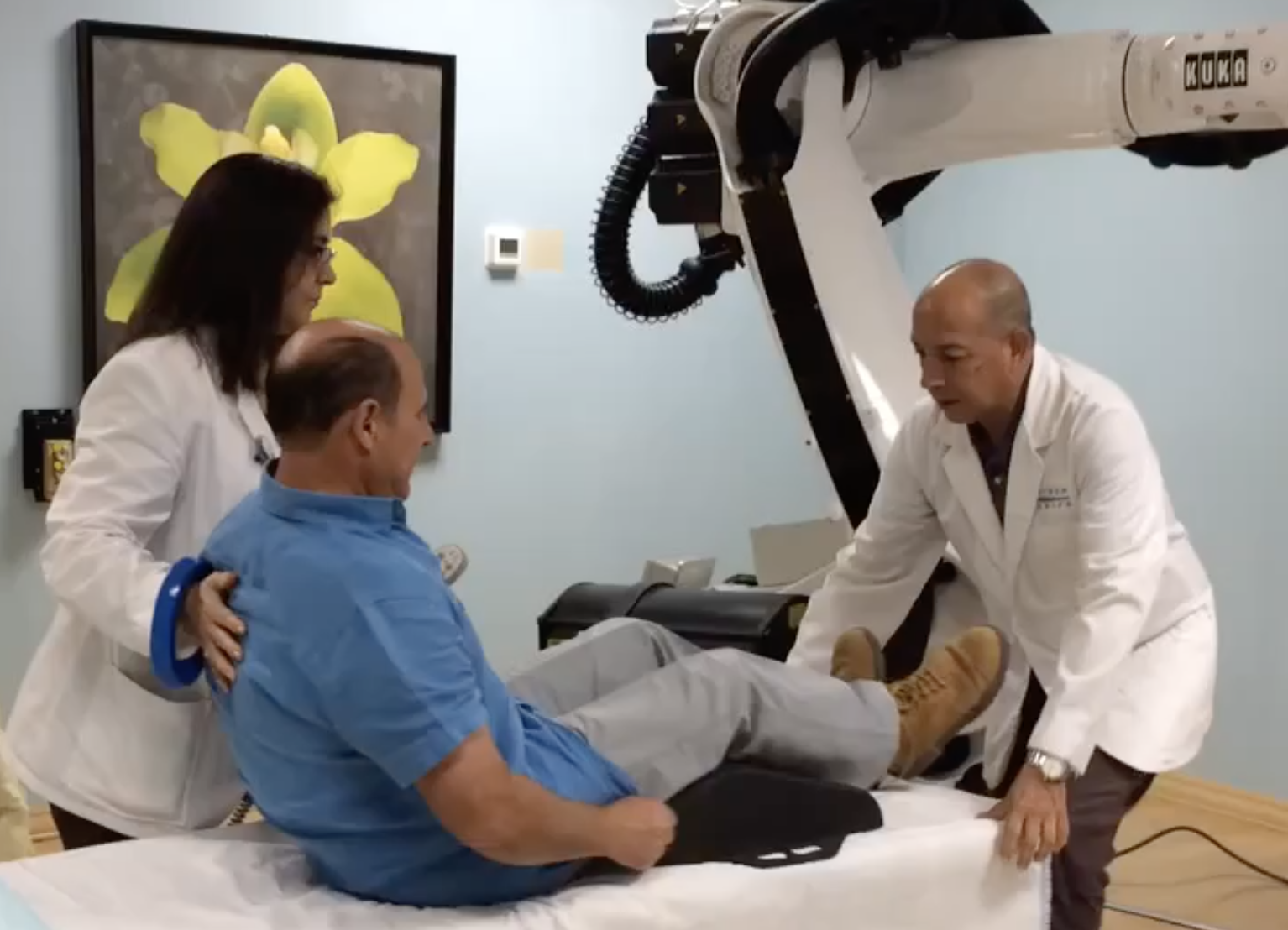CyberKnife, also known as Stereotactic Ablative Radiotherapy Benefits Oligometastatic Prostate Cancer:
CyberKnife, also known as Stereotactic ablative radiotherapy appeared to improve clinical outcomes compared with observation among men with oligometastatic prostate cancer, according to results of the randomized phase 2 ORIOLE study published in JAMA Oncology.
The treatment was enhanced by total consolidation of disease identified by prostate-specific membrane antigen-targeted PET and induced a systemic immune response. Baseline immune phenotype and tumor mutation status may help predict benefits of stereotactic ablative radiotherapy (SABR) for these men, researchers noted.
Current Standard of Care for Prostate Cancer That Has Spread:
“The current standard of care for oligometastatic prostate cancer is systemic therapy in the form of hormones with either stronger hormone therapy or chemotherapy,” Phuoc T. Tran, MD, PhD, professor of radiation oncology and molecular radiation sciences at Sidney Kimmel Comprehensive Cancer Center at Johns Hopkins, told Healio. “Some data suggest treating the primary tumor may also be of benefit. These current therapies extend life, but none is thought to be curative.”
Metastatic Prostate Cancer Prognosis:
Metastatic prostate cancer remains incurable despite advances in treatment of hormone-sensitive and castration-resistant disease. About 20% of the 1.3 million men diagnosed with prostate cancer worldwide each year have metastatic disease, but it remains unclear what percentage have oligometastatic disease, defined as cancer that has spread from a primary tumor to one to three sites in the body.
Studies Prove Effectiveness of CyberKnife SABR:
Previous studies have shown that SABR significantly extends PFS and OS among patients with oligometastatic non-small cell lung cancer when combined with maintenance systemic therapy. SABR also has demonstrated efficacy in treating oligometastases when combined with standard of care systemic therapy across multiple cancer types.
Current Study Results on Prostate Cancer That Has Spread:
Tran and colleagues randomly assigned 54 men (median age, 68 years) with recurrent hormone-sensitive oligometastatic prostate cancer to SABR (n = 36) or observation (n = 18) to determine whether SABR improves oncologic outcomes in this patient population.
All men had one to three metastases detectable by conventional imaging and did not receive androgen deprivation therapy within 6 months of enrollment.
Progression at 6 months, defined by PSA level increase of at least 2 ng/dL and 25% above nadir, as well as progression detected by conventional imaging, symptomatic progression, ADT initiation for any reason or death, served as the primary endpoint.
Secondary endpoints included toxicity of SABR, local control at 6 months with SABR, PFS, quality-of-life, and concordance between conventional imaging and PSMA-targeted PET in the identification of metastatic disease.
What Were The Results of the Prostate Cancer Study?
Results showed progression at 6 months occurred among seven men (19%) in the SABR group and 11 men (61%) in the observation group (P = .005). A lower proportion of men in the SABR group experienced disease progression by PSA level at 6 months compared with the observation group (11% vs. 50%; P = .005).
Men in the SABR group also experienced longer median PFS compared with men in the observation group (not reached vs. 5.8 months; HR = 0.3; 95% CI, 0.11-0.81).
Additionally, total consolidation of PSMA radiotracer-avid disease reduced the risk for new lesions at 6 months (16% vs. 63%; P = .006).
Researchers observed no grade 3 or greater toxicities in either group.
T-cell receptor sequencing identified increased clonotypic expansion following SABR and found correlation between baseline clonality and progression with SABR only (P = .03), according to the study.
The study’s small sample size served as a limitation.
“This ORIOLE randomized trial adds to growing data that support clinical practice change using SABR in oligometastatic prostate cancer,” Tran said. “The next steps are testing rationale combinations of SABR with systemic therapies using precision medicine-informed approaches. Ultimately, we need validation from larger phase 3 trials before this becomes the standard of care.”
Taken together, these observations support the idea that all detectable oligometastatic lesions should be systematically ablated — if feasible — to help maximize oligometastatic cancer cure, Carlo Greco, MD, clinical researcher in the department of radiation oncology at Champalimaud Centre for the Unknown in Portugal, and Zvi Fuks, MD, professor and radiologist at Memorial Sloan Kettering Cancer Center, wrote in an accompanying editorial.
“It is anticipated that the next generation of clinical trials in patients with oligometastatic disease might directly address the models and hypotheses discussed here to assess the feasibility and efficacy of cure for early metastatic disease, primarily via radioablation,” Fuks and Greco wrote. “However, buildup of such an investigational effort depends on step-by-step resolutions of interim critical components of the overall pathway, such as those provided by the phase 2 ORIOLE trial reported herein.” – by John DeRosier
For more info: Contact the CyberKnife Center of Miami at 305-279-2900. Our prostate cancer experts are happy to talk to you about your best treatment option for your particular type of prostate cancer. Whether that is CyberKnife Radiation Therapy or not.
Our goal is to get cancer behind you as effectively, quickly and easily as possible.

